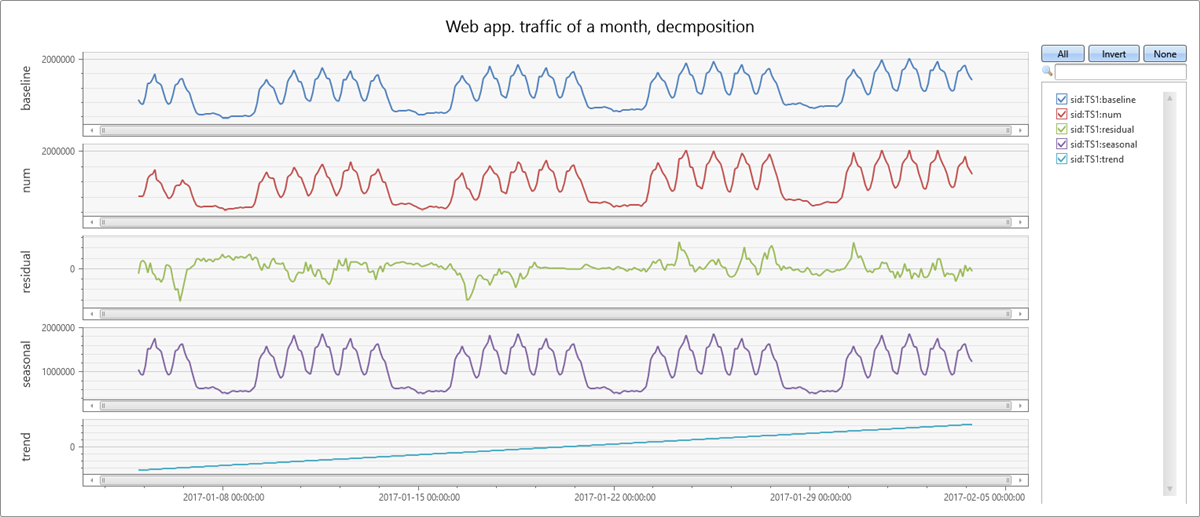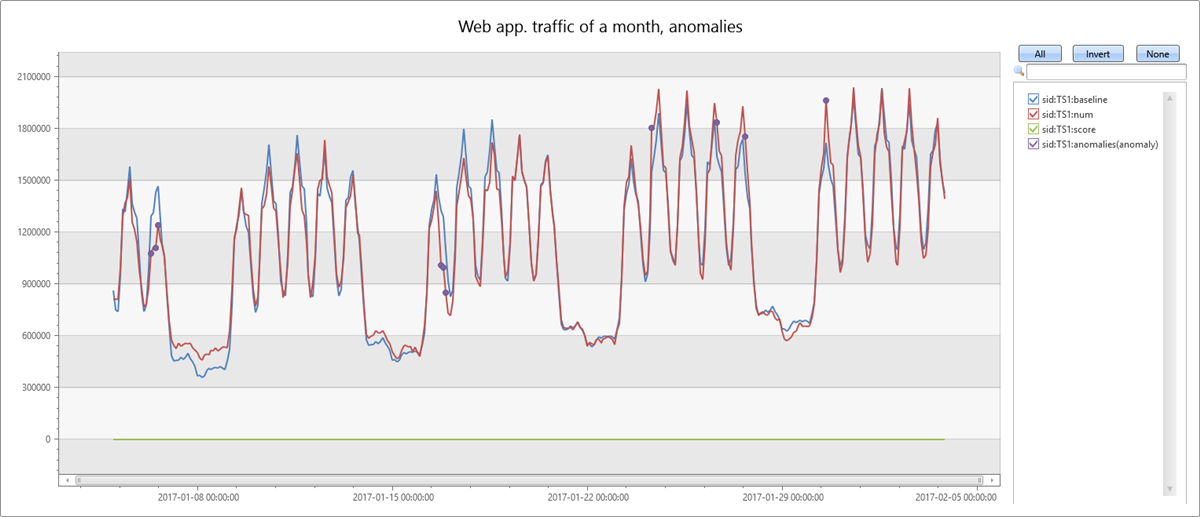异常检测和预测
云服务和 IoT 设备生成可用于获取见解的遥测数据,例如监视服务运行状况、物理生产流程和使用趋势。 执行时序分析是识别这些指标模式与典型基线模式相比的偏差的一种方法。
Kusto 查询语言 (KQL) 原生支持创建、操作和分析多个时序。 通过 KQL,可以在几秒钟内创建和分析数千个时序,实现准实时监视解决方案和工作流。
本文详细介绍 KQL 的时序异常情况检测和预测功能。 适用的时序函数基于一个可靠的已知分解模型,其中的每个原始时序将分解成季节性组件、趋势组件和残余组件。 异常情况是根据残余组件上的离群值检测的,而预测则是通过推算季节性组件和趋势组件执行的。 KQL 实现显著增强了基本分解模型,它可以自动检测季节性、可靠分析离群值,并使用矢量化实现在几秒钟内处理数千个时序。
先决条件
- Microsoft 帐户或 Microsoft Entra 用户标识。 无需 Azure 订阅。
- 有关时序功能的概述,请参阅时序分析。
时序分解模型
用于时序预测和异常情况检测的 KQL 本机实现使用一个已知的分解模型。 此模型将应用到预期的指标时序,以揭示定期行为和趋势的行为(例如服务流量、组件检测信号和 IoT 定期度量值),从而预测将来的指标值和检测异常的指标值。 此回归过程的假设条件是,时序是随机分布的,而不是存在事先已知的季节性行为和趋势行为。 然后,你可以通过季节性组件和趋势组件(统称为基线)预测将来的指标值,并忽略残余部分。 也可以仅使用残余部分基于离群值分析检测异常值。
若要创建分解模型,请使用函数 series_decompose()。 series_decompose() 函数采用一系列时序,并自动将每个时序分解成其季节性、趋势、残余和基线组件。
例如,可以使用以下查询分解内部 Web 服务的流量:
let min_t = datetime(2017-01-05);
let max_t = datetime(2017-02-03 22:00);
let dt = 2h;
demo_make_series2
| make-series num=avg(num) on TimeStamp from min_t to max_t step dt by sid
| where sid == 'TS1' // select a single time series for a cleaner visualization
| extend (baseline, seasonal, trend, residual) = series_decompose(num, -1, 'linefit') // decomposition of a set of time series to seasonal, trend, residual, and baseline (seasonal+trend)
| render timechart with(title='Web app. traffic of a month, decomposition', ysplit=panels)

- 原始时序带有 num(如红色所示)标签。
- 分解过程首先使用函数
series_periods_detect()自动检测季节性,并提取季节性模式(如紫色所示)。 - 从原始时序中减去季节性模式,并使用函数
series_fit_line()运行线性回归,以找到趋势组件(如浅蓝色所示)。 - 该函数减去趋势,余下的部分是残余组件(如绿色所示)。
- 最后,该函数将季节性组件和趋势组件相加,以生成基线(如蓝色所示)。
时序异常情况检测
函数 series_decompose_anomalies() 查找一组时序中的异常点。 此函数调用 series_decompose() 来生成分解模型,然后对残余组件运行 series_outliers()。 series_outliers() 使用 Tukey 隔离测试计算残余组件的每个点的异常评分。 异常评分大于 1.5 或小于 -1.5 分别表示异常有轻微的上升或下降。 异常评分大于 3.0 或小于 -3.0 表示明显的异常。
使用以下查询可以检测内部 Web 服务流量的异常:
let min_t = datetime(2017-01-05);
let max_t = datetime(2017-02-03 22:00);
let dt = 2h;
demo_make_series2
| make-series num=avg(num) on TimeStamp from min_t to max_t step dt by sid
| where sid == 'TS1' // select a single time series for a cleaner visualization
| extend (anomalies, score, baseline) = series_decompose_anomalies(num, 1.5, -1, 'linefit')
| render anomalychart with(anomalycolumns=anomalies, title='Web app. traffic of a month, anomalies') //use "| render anomalychart with anomalycolumns=anomalies" to render the anomalies as bold points on the series charts.

- 原始时序(如红色所示)。
- 基线(季节性 + 趋势)组件(如蓝色所示)。
- 原始时序顶层的异常点(如紫色所示)。 异常点明显偏离于预期的基线值。
时序预测
函数 series_decompose_forecast() 预测一组时序的未来值。 此函数调用 series_decompose() 生成分解模型,然后针对每个时序,推断未来的基线组件。
使用以下查询可以预测下一周的 Web 服务流量:
let min_t = datetime(2017-01-05);
let max_t = datetime(2017-02-03 22:00);
let dt = 2h;
let horizon=7d;
demo_make_series2
| make-series num=avg(num) on TimeStamp from min_t to max_t+horizon step dt by sid
| where sid == 'TS1' // select a single time series for a cleaner visualization
| extend forecast = series_decompose_forecast(num, toint(horizon/dt))
| render timechart with(title='Web app. traffic of a month, forecasting the next week by Time Series Decomposition')

- 原始指标(如红色所示)。 未来值缺失,已按默认设置为 0。
- 推断基线组件(蓝色)以预测下一周的值。
可伸缩性
Kusto 查询语言语法支持通过单个调用来处理多个时序。 其独特的优化实现可以提高性能,在近实时方案中监视数千个计数器时,若要有效进行异常情况检测和预测,这种优势非常关键。
以下查询显示同时处理三个时序的结果:
let min_t = datetime(2017-01-05);
let max_t = datetime(2017-02-03 22:00);
let dt = 2h;
let horizon=7d;
demo_make_series2
| make-series num=avg(num) on TimeStamp from min_t to max_t+horizon step dt by sid
| extend offset=case(sid=='TS3', 4000000, sid=='TS2', 2000000, 0) // add artificial offset for easy visualization of multiple time series
| extend num=series_add(num, offset)
| extend forecast = series_decompose_forecast(num, toint(horizon/dt))
| render timechart with(title='Web app. traffic of a month, forecasting the next week for 3 time series')

总结
本文档详细介绍了用于时序异常情况检测和预测的本机 KQL 函数。 每个原始时序将分解成季节性、趋势和残余组件,以检测异常情况和/或进行预测。 这些功能可用于近实时监视方案,例如故障检测、预测性维护以及需求和负载预测。
相关内容
- 了解 KQL 的机器学习功能